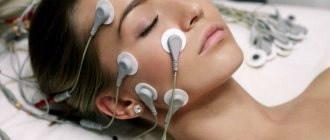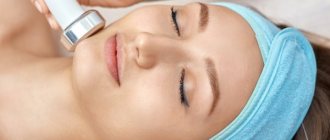Galvanic cleaning: what is it?
The procedure uses a special apparatus, the operation of which is based on the production of galvanic current. With its help, electrophoresis is activated. This is a process in which electricity is the driving force behind dispersed particles.
If you bring a negatively charged electrode close to the skin, it will begin to attract positively charged ions. Under the influence of current, they become active atoms, lowering the pH of the skin, alkalizing it.
The procedure uses a special solution. Most often we are talking about 5% sodium chloride, 1% sodium bicarbonate or 2% sodium salicylate. When the environment in the pores changes, saponification of the triglycerides that make up sebum occurs. Sebaceous plugs come to the surface and are removed manually by a cosmetologist. Under the influence of acidic electrolysis products, the bonds between the cells of the stratum corneum are destroyed, promoting their exfoliation.
Electrophoresis
In cosmetology, electrophoresis of drugs is more often called iontophoresis. The term is not entirely accurate, but is already familiar. Technically, iontophoresis differs from galvanization only in the presence of a medicinal substance under the electrode.
Electrophoresis (iontophoresis) of saponifying substances in combination with the action of the negative pole of galvanic current is used in cosmetology for saponification of comedones. The procedure using galvanization and iontophoresis devices is called disincrustation, or galvanic cleaning.
The ability of galvanic current to deliver medicinal substances deep into the skin is used in the procedure of ionic mesotherapy, or ionotherapy. In essence, this is electrophoresis of medicinal substances using stationary electrodes. The procedure is carried out without injections. Indications, treatment tactics and cocktail recipes correspond to the schemes accepted in mesotherapy, adjusted for the phoretic nature of the drugs.
Indications for galvanic facial cleansing
Disincrustation is carried out in the following cases75:
- open and closed comedones;
- acne (except for periods of exacerbation);
- oily and combination skin;
- the first signs of photoaging;
- melasma;
- post-inflammatory hyperpigmentation;
- seborrhea.
If the comedones are shallow, the device allows you to clean the pores, completely replacing mechanical cleaning. When they are deep, these two procedures are combined to achieve a better effect.74
Contraindications to facial disincrustation
Contraindications can be divided into general and specific, which are taken into account only when the procedure is performed on the face.
General contraindications include75:
- inflammatory and purulent processes;
- oncological diseases;
- pregnancy;
- individual intolerance to current;
- the presence of large areas with a violation of the integrity of the skin;
- systemic skin diseases;
- pacemaker;
- renal or heart failure.
If galvanic facial cleansing (disincrustation) is performed on the face, the contraindications will be75:
- eczema;
- inflammatory acne elements;
- thyroid diseases;
- dental cysts;
- tooth sensitivity;
- platinum or gold reinforcement.
The procedure is not recommended for dry skin types. The list of contraindications may be wider. Before galvanic cleaning, you should consult a dermatologist or cosmetologist. The specialist will tell you about the pros and cons of the method, and whether it is right for you specifically.
Terms and concepts used in electrophoresis and galvanization
- To carry out the procedure, two electrodes are always used: positive and negative.
- The negative electrode is called the cathode. Usually all wires and connections from the negative pole are made in black.
- The positive electrode is called the anode. It is marked in red.
- The electrodes used in the procedure can be of different sizes. On a smaller electrode, the current density is higher and its effect is more pronounced. The smaller electrode is called the active electrode.
- An active electrode is applied to the problem area.
- Passive (indifferent) - electrode with a larger area. It is usually held in the patient's hand or attached to the body.
- A passive electrode can also carry a therapeutic load. Bipolar iontophoresis can be performed - negatively charged ions will be absorbed from the negative electrode, and positively charged ones, respectively, from the positive electrode.
- If the electrodes are equal in area, more pronounced sensations occur under the negative electrode.
- The polarity of a substance is the charge of its active particles. Ions of the same name are repelled from the electrode and go deep into the tissue. Therefore, negative ions are introduced from the negative electrode.
How is the facial galvanization procedure performed?
Galvanic cleaning does not require preparation. Throughout the entire procedure, the patient holds a neutral electrode in his hands, which makes it possible to generate a galvanic current. The session is carried out in several stages75:
- The cosmetologist cleanses the face of cosmetics and dust particles that settle on the face.
- The specialist prepares the electrode: wraps it in a napkin, which is soaked in a special solution (disincrustant); alternatively, a fabric mask soaked in it can be placed on the patient’s face. The electrode may look like a sponge roller soaked in an electrolyte solution.
- The cosmetologist treats the face with a negative electrode, paying special attention to the T-zone and problem areas. Next, the specialist changes the polarity of the electrode to restore the acid-base balance. At the end of the procedure, a restorative agent is applied to the face.
Most often, treating the skin with electric current does not cause pain, but in some cases patients note tingling sensations. The session lasts about half an hour. To achieve maximum effect, the procedure is carried out in a course of 4 sessions, with a 2-4 week break between them. The course must be repeated approximately once every 2-3 months.75
Galvanization
Galvanization is carried out using stationary, movable electrodes or using baths. A saline solution or conductive gel is used to conduct the current. The choice of active electrode depends on the indications. Negative and positive electrodes have different effects on tissue:
Indications for galvanization: all types of seborrhea, dry aging skin, post-acne scars.
How do substances penetrate the skin using current?
- A constant electric current causes the movement of ions.
- Using direct current, both small and larger particles of medicinal substances carrying an electrical charge can be injected through the skin and mucous membranes.
- The method of introducing medicinal ions through the skin and mucous membranes using current is called electrophoresis (iontophoresis).
- Charged particles are repelled from the electrode of the same name and go deep into the skin.
- Thus, negatively charged ions are introduced from the negative electrode.
- The greatest mobility of medicinal substances dissolved in water.
- The administered medicinal ions penetrate the epidermis and accumulate in the upper layers of the dermis. With iontophoresis, substances go to a depth of 1.5 cm.
- After the procedure, a depot is formed in the affected area, from which the drug gradually penetrates into the cells. The period of action of the medicinal substance ranges from 3 hours to 15-20 days.
Is skin care necessary after galvanophoresis?
Galvanic cleansing is most effective in cleansing the skin, but it is not a way to treat acne. After the procedure, the skin restores normal breathing and healthy color. In addition to the cleansing effect, it is possible to achieve its regeneration and rejuvenation. The structure of epithelial cells becomes denser, the procedure contributes to less sebum production.
In the first three days after the procedure, the sensitivity of the skin increases, so it is necessary to protect it from UV rays, mechanical stress, and aggressive cosmetics, because this can aggravate the acne problem. It is also necessary to avoid visiting the sauna, swimming pool, and solarium. The cosmetologist will recommend masks for home care that will help the skin recover.75
Electrotherapy: types and indications
Home → Useful information → Electrotherapy: types and indications
There is information according to which even ancient people used the electric field for medicinal purposes. They were used to treat paralysis, nervous and rheumatic diseases.
They received electrical discharges from amber, electric fish and other creatures.
In the second half of the 18th century, the galvanic element was invented and the widespread use of electrotherapy in medicine began, which was improved every year, based on the principles of the physiology of the human body and the laws of electromagnetic fields.
Electrotherapy is a currently widely used type of physiotherapeutic treatment that involves influencing organs and tissues through an electromagnetic field or electric current. This procedure is effective in combating various pathologies and is both a primary and an additional method of therapy.
| Injurymap Flickr |
Therapeutic effects of electrotherapy procedures:
- local, covering a specific affected area;
- reflex-segmental - through electric current, somatovegetative reflexes are evoked that regulate the activity of internal organs, blood vessels, glands, smooth muscles;
- a general effect that improves the processes of recovery and regeneration with the mobilization of vitality and strengthening of the immune system.
Classification of electrotherapy methods:
- By mode of exposure: constant and alternating pulse currents.
- By voltage value: currents with high and low frequencies.
- By the nature of energy: contact procedures and remote ones.
Types of electrotherapy procedures
Physiotherapeutic methods of electrotherapy include over a dozen different procedures based on the action of electric and electromagnetic fields on the cells and tissues of the body.
Why do acne* not go away after galvanization?
Galvanophoresis is a cosmetological technique that can be used as an auxiliary procedure in the treatment of acne. The main therapy should be medication and prescribed by a dermatologist. The first reason why acne does not go away* is that the patient visits a cosmetologist, but neglects the dermatologist’s prescriptions.
Lack of progress in treatment may be due to the fact that the cause of acne has been incorrectly identified or not identified at all. For example, if the appearance of acne is associated with a hormonal imbalance, you must additionally contact an endocrinologist. Problems with the gastrointestinal tract require monitoring by a gastroenterologist. Each specialist can prescribe additional medications in addition to those prescribed by the dermatologist.
Galvanosis - symptoms and treatment
The oral cavity is a complex biological environment. A huge number of electrochemical processes take place in its soft tissues and at the border with saliva. One of them is the formation of galvanic microcurrents - weak electrical impulses. They occur when saliva comes into contact with metal structures installed in the mouth. This is a normal process, but with increased microcurrents, various diseases can develop, and first of all, galvanosis. Previously, this disease was called intolerance to alloys of metal inclusions in the oral cavity.
Galvanosis is a dental disease that occurs as a result of increased exposure to galvanic currents on the tissues of the oral cavity. This current appears against the background of the electrochemical interaction of metal dental structures with saliva.
For this pathological condition, the characteristic symptoms are: a metallic taste in the mouth, dryness of the oral mucosa, distortion of taste and burning of the tongue. Often, with galvanosis, neurological disorders such as headaches, increased irritability, etc. are observed.
Patients begin to notice the first symptoms within 1-2 months after the installation of metal prostheses made of stainless steel, a clasp cobalt chrome prosthesis, or a repeat orthopedic procedure using a new bridge prosthesis made of a gold alloy. Less commonly, galvanosis occurs after the use of other metal alloys.
An analysis of clinical studies showed that “intolerance” to certain materials of crowns and dentures is characteristic of 15-43% of people [15].
Modern dentists identify several main reasons for the development of galvanosis after prosthetics with metal structures:
1. The presence of a galvanic element . The factors of its formation are:
- the difference in the electrode potential of different metals that make up the alloy used to make the prosthesis;
- different compositions of the same metal alloys;
- structural difference between identical metal alloys;
- violation of material manufacturing technology;
- low quality materials;
- medical errors during the installation or implementation of materials (for example, the manufacture of a clasp denture in the presence of dissimilar metals in the mouth).
2. Toxic effects of heavy metals and trace elements , in particular copper, chromium, cadmium ions, etc.
3. Individual characteristics of the human body and the presence of certain diseases:
- individual intolerance to individual components of a metal prosthesis;
- peculiar electrolyte properties of saliva;
- the presence of chronic foci of infection - caries, periodontitis, candidiasis, etc.;
- diseases of internal organs, in particular the digestive system - chronic gastritis, stomach ulcer, duodenal ulcer, etc.;
- violations of personal oral hygiene.
Galvanosis is one of the pathological conditions, the causes of development and pathogenesis of which today remain not fully understood. Despite this fact, dentists clearly know the main symptoms of the disease and have a sufficient basis for its effective treatment [2][3].
How to treat acne at home?
Azelik gel can be used in the treatment of mild to moderate acne5,9. The drug normalizes keratinization processes and reduces the level of free fatty acids on the skin5. Azelik gel exhibits antimicrobial activity against Staphylococcus epidermidis and Propionibacterium acnes5. The anti-inflammatory effect of the drug can be explained by a decrease in the metabolism of neutrophils and their production of free radical forms of oxygen5.
*acne









